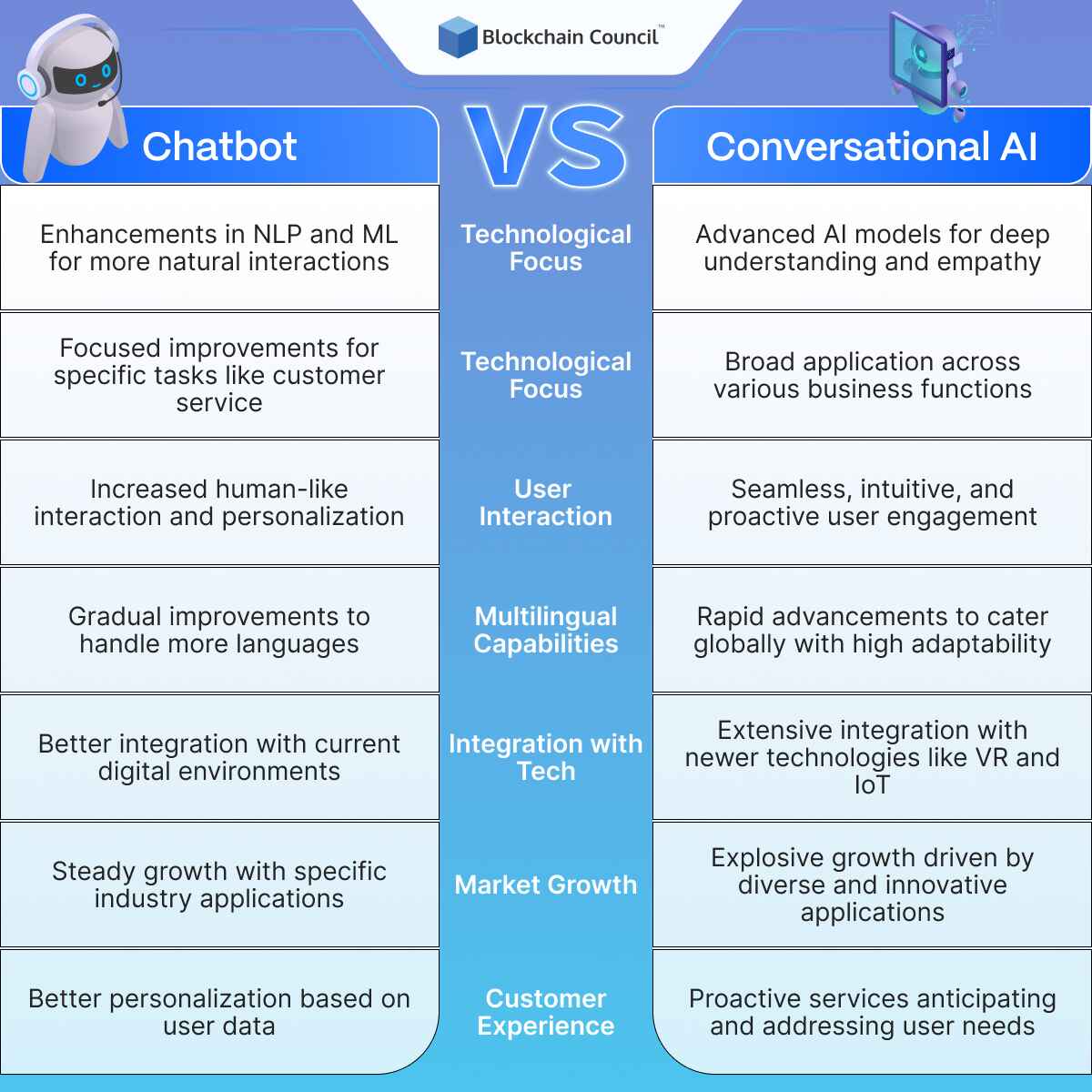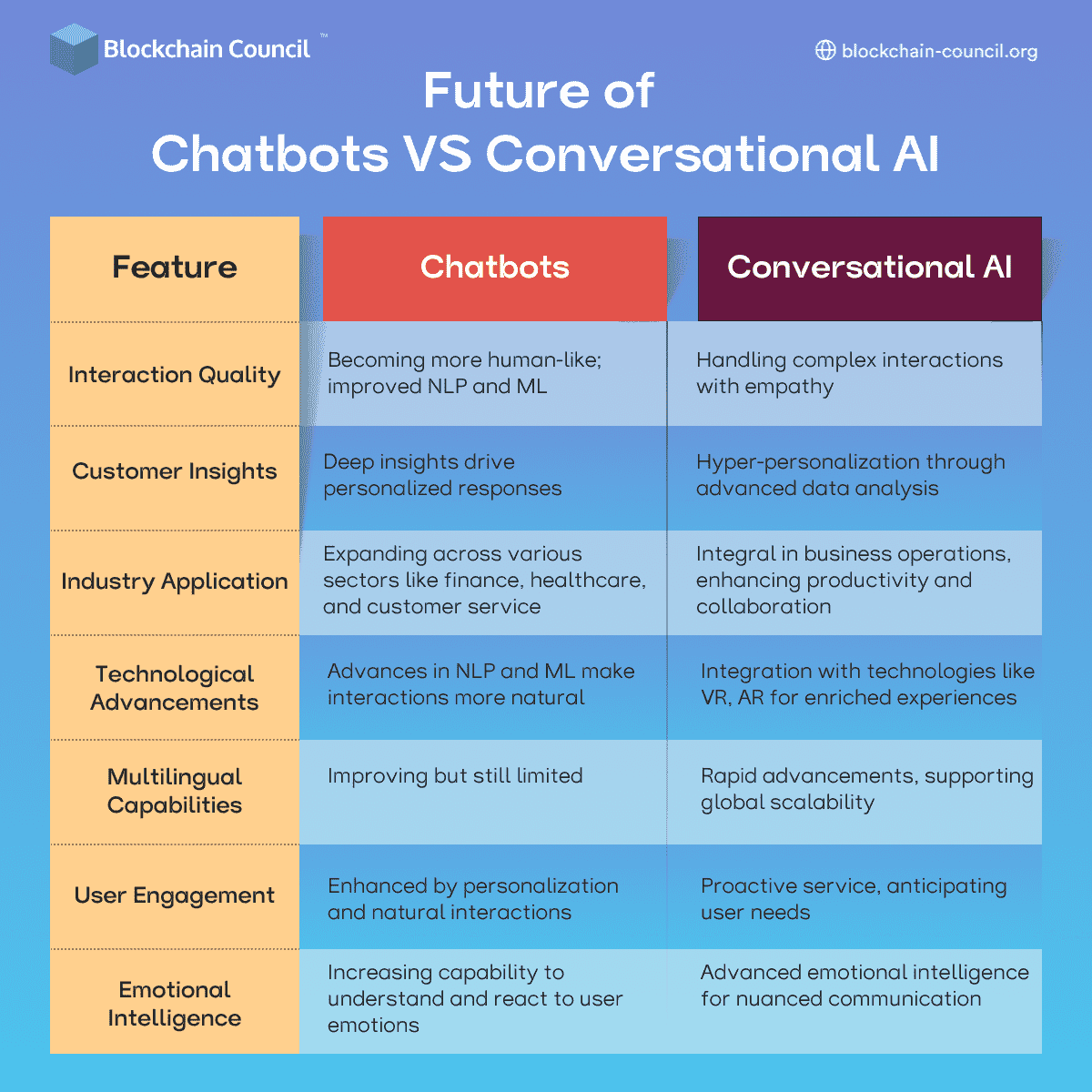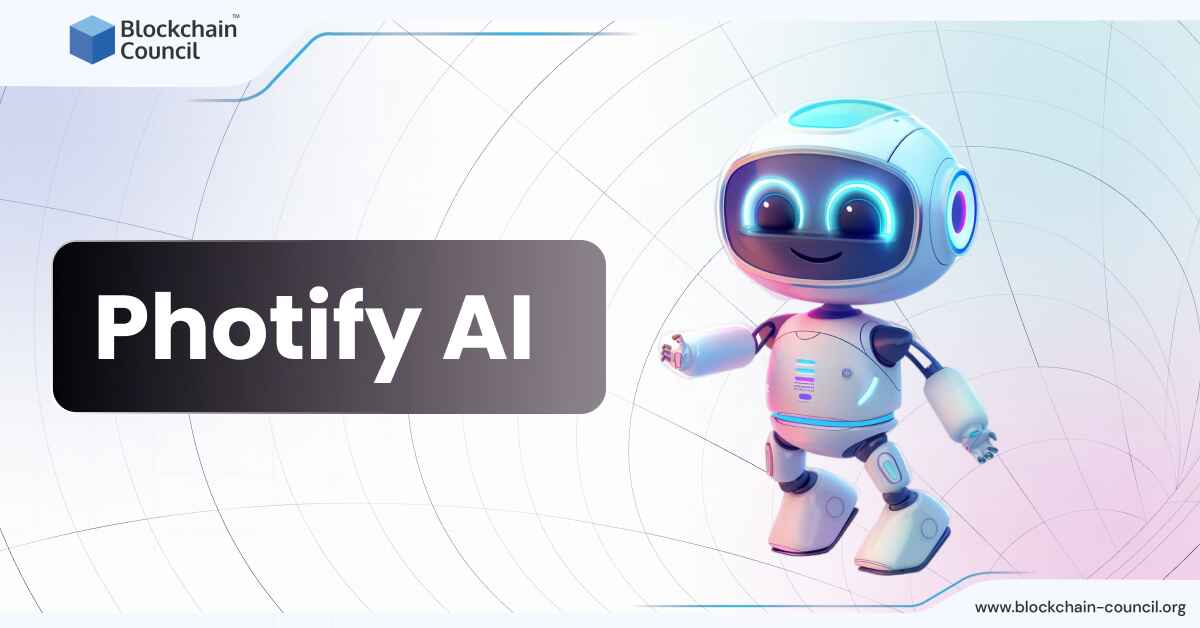
- Blockchain Council
- September 02, 2024
The rapid advancement in artificial intelligence has revolutionized how businesses interact with their customers. This has led to a surge in the adoption of chatbots and conversational AI. But what’s the difference between the two and which one is the best for your business? Let’s find out!
What are Chatbots?
Chatbots are computer programs designed to simulate conversation with human users. They can operate in various ways: some follow predefined rules that trigger specific responses to certain keywords or phrases, while others are more advanced, utilizing artificial intelligence (AI) to respond in a more human-like manner to a wide range of queries.
Examples of a Chatbot
- Dom from Domino’s: Allows customers to order pizza through Facebook Messenger and other platforms.
- HelloFresh’s Freddy: Assists in managing customer service inquiries on Facebook Messenger, providing promo codes and information.
- Ask Benji: Helps Arizona students with the financial aid process via text messages.
What is Conversational AI?
Conversational AI is a broader term that encompasses technologies enabling computers to simulate human-like conversations. Unlike simple chatbots, conversational AI systems can understand language naturally, process user intentions, and respond contextually. This technology is built on advances in natural language processing (NLP) and machine learning and allows for a more dynamic interaction.
Example of Conversational AI
Devices like Amazon’s Alexa or Apple’s Siri. They can understand your questions or commands and help you do things like setting alarms, playing music, or checking the weather through voice commands.
How Chatbots Relate to Conversational AI
Chatbots are computer programs designed to simulate conversation with human users. They can be simple, following predefined rules to respond to specific inputs (rule-based chatbots), or more advanced, utilizing artificial intelligence (AI) to offer more dynamic responses.
Conversational AI refers to the subset of AI technologies that enable machines to understand, process, and respond to human language in a way that mimics human conversation. This includes chatbots, but extends to more complex systems like virtual assistants, which can understand context, learn from interactions, and make decisions.
The connection between the two is that all conversational AI can be considered a form of chatbot, but not all chatbots qualify as conversational AI. Rule-based chatbots, for example, do not employ AI; they simply follow scripts. On the other hand, AI-driven chatbots (a form of conversational AI) can understand nuances in language, adapt their responses based on the conversation’s context, and learn over time to improve their interactions.
Chatbots VS Conversational AI
Chatbot VS Conversational AI: Examples in customer service
Chatbot Use Cases in Customer Service
Chatbots are used in customer service to make things easier and faster. Here are some common ways they’re used:
- Answering Questions: Chatbots can give quick answers to common questions like “What are your store hours?” or “How do I return an item?” This means customers can get help any time, without waiting for a human.
- Booking and Reservations: For businesses like restaurants or airlines, chatbots can handle bookings. Customers can simply tell the chatbot when they want to book a table or a flight, and the chatbot takes care of it.
- Helping with Purchases: Chatbots can guide customers through the process of finding and buying products. For example, if someone wants to buy a phone, the chatbot can suggest models, explain features, and even help add items to the cart.
- Handling Complaints: When customers are unhappy, chatbots can start the conversation to find out the problem. They can collect details and pass them to a human who can help solve more complex issues.
Conversational AI Chatbot Use Cases in Customer Service
Conversational AI chatbots are a step up from regular chatbots because they can understand and talk more like humans. Here’s how they help in customer service:
- Understanding Complex Requests: These chatbots are better at figuring out what customers really want, even if the questions are not straightforward. For example, they can understand, “I bought a laptop last week, and it’s not turning on,” and know the customer might need a repair or a return.
- Personalized Service: Conversational AI can look at a customer’s past interactions and preferences to offer personalized help. If a customer regularly orders pet food, the chatbot might ask if they want to reorder the same brand and quantity as last time.
- Continuous Learning: These chatbots learn from each conversation. They get better at answering questions and can handle more tasks over time, reducing the need for human help.
- Multilingual Support: Conversational AI can talk to customers in multiple languages, making it easier for businesses to serve people from different parts of the world without hiring bilingual staff.
Benefits of Conversational AI over Traditional Chatbots
Conversational AI offers several significant benefits over traditional chatbots. Unlike basic chatbots that rely on predefined rules and scripts to respond to queries, conversational AI uses advanced technologies like natural language processing (NLP) and machine learning.
This allows it to understand the context and intent behind user inquiries, leading to more intelligent and human-like interactions. Consequently, conversational AI can handle complex queries and provide more accurate, context-aware responses. Thus, it is capable of offering personalized experiences and suggestions.
Additionally, conversational AI can learn and adapt over time, improving its responses based on previous interactions. This adaptability ensures that the AI becomes more efficient in dealing with customer queries, which can enhance user satisfaction and engagement. For businesses, this translates to better customer service and potential increases in customer loyalty and retention.
How to Create a Conversational Bot?
Creating a conversational AI bot involves several key steps:
- Identify what you want your bot to achieve. Is it for customer service, sales, or something else? Knowing the purpose will guide the features and capabilities you need to develop.
- Depending on your technical expertise and resources, you may choose to use platforms like Google’s Dialogflow, Microsoft’s Bot Framework, or tools provided by IBM Watson. These platforms provide the necessary NLP capabilities and integration options.
- Map out how interactions should proceed, which includes planning how the bot should respond to various inputs and what actions it should be able to perform. This is crucial for making the interaction feel natural and efficient.
- Feed the bot with relevant data so it can learn and understand the nuances of human language. This training involves both the quality and quantity of data, and it’s a continuous process to improve the bot’s accuracy and functionality.
- Before going live, thoroughly test the bot with potential users to identify any flaws or areas of improvement. Feedback from these tests will help refine the bot’s responses and performance.
- Once satisfied, deploy the bot and continuously monitor its interactions to ensure it performs well. Regular updates and maintenance will be required to adapt to new user needs or changes in the domain it serves.
Future of Chatbots VS Conversational AI
Chatbot VS Conversational AI – Which is Best for Your Business?
Chatbots, especially rule-based ones, are effective for businesses needing to handle straightforward, repetitive queries efficiently. Because they operate on predefined rules, they’re also simpler and cheaper to implement and maintain.
On the other hand, Conversational AI offers more advanced interactions by using technologies like machine learning and natural language processing to understand and respond to user queries. This is particularly valuable for businesses that require deep customer engagement, such as those in hospitality, high-end retail, or healthcare.
For example, if your business frequently deals with complex customer service queries that require understanding context or multiple questions within a single request, conversational AI would be the better choice. It’s capable of integrating with various platforms, ensuring a consistent experience across all customer touchpoints, which can significantly enhance customer satisfaction and loyalty.
In contrast, if your business mainly needs to handle simple, defined tasks and you wish to automate these efficiently, a rule-based chatbot might be all you need. They can perform tasks like scheduling appointments, providing business hours, and handling standard customer service inquiries without the need for more sophisticated AI capabilities.
Ultimately, the choice between a chatbot and conversational AI depends on how complex your customer interactions are and how much you’re willing to invest in AI technology.
Conclusion
Chatbots offer a straightforward, rule-based approach to customer interactions, making them suitable for basic queries and functions. Conversational AI, however, stands out with its ability to process and generate more natural responses, learn from interactions, and handle a broader range of inquiries. Choosing between the two depends on the specific needs of a business, the complexity of the tasks, and the level of interaction required.
FAQs
What is a chatbot?
- A chatbot is a computer program designed to simulate conversation with human users.
- It can operate through predefined rules or utilize artificial intelligence (AI) for more dynamic responses.
- Chatbots are commonly used for tasks like answering questions, booking reservations, and handling customer service inquiries.
- Examples include Domino’s Dom for pizza orders and HelloFresh’s Freddy for customer service on Facebook Messenger.
How does conversational AI differ from chatbots?
- Conversational AI encompasses technologies that enable computers to simulate human-like conversations.
- Unlike simple chatbots, conversational AI systems can understand language naturally, process user intentions, and respond contextually.
- Devices like Amazon’s Alexa or Apple’s Siri are examples of conversational AI.
- While all conversational AI can be considered a form of chatbot, not all chatbots qualify as conversational AI.
What are the benefits of conversational AI over traditional chatbots?
- Identify the bot’s purpose, such as customer service or sales, to guide development.
- Choose platforms like Google’s Dialogflow or Microsoft’s Bot Framework for NLP capabilities.
- Map out interactions and responses to ensure a natural flow.
- Train the bot with relevant data to improve accuracy and functionality.
- Thoroughly test before deployment and continuously monitor interactions for improvements.







































































 Guides
Guides News
News Blockchain
Blockchain Cryptocurrency
& Digital Assets
Cryptocurrency
& Digital Assets Web3
Web3 Metaverse & NFTs
Metaverse & NFTs
